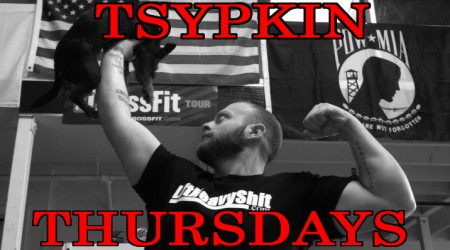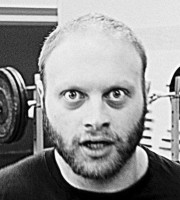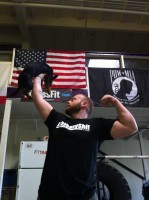You all know and love AC. For the next few weeks, we’ll be posting some of his coaching articles on the individual lifts. In this first installment, AC discusses the Press, a lift he’s pretty dece at. He’s hit 285 for a single, and 260×4…at under 220lbs bodyweight. So, you know, maybe he kinda knows what he’s talking about, and stuff. I heard he also likes Batman. – Jacob
We’re going to talk about the Press. Soon, I’ll also talk about the entire process of Squatting and Benching. Yes I capitalized those words, because fuck you, that’s why. The first thing we talk about when we discuss the Press is grip. When most people Press their grip is usually way too wide. The forearm should be perpendicular to the bar. That’s 90 degrees. Not angled in and NOT angled out. Better external rotation can be achieved with a perpendicular grip. With that said, just because you are gripping it where you are supposed to doesn’t mean that external rotation magically happens. Justin talks about this HERE. That should give you a visual of what to do with your grip and your elbows. You should also have an erection by now as well. It’s hard to explain the grip via writing so just watch the video in the link I have provided.
Moving on, the elbows have to be cued. Some of you have your own cues. I just say to myself “Elbows in” or “Elbows.” Remember – if you know the meaning behind the cue you can shorten it to one word. If your cue is “Anal,” but you know what that means (elbows externally rotated), then you can yell “Anal!” to yourself all day. With a compact wrist and the elbows in, the drive from chest/chin (depending on anatomy) will be much faster and easier. That’s assuming you haven’t been Pressing with internally rotated elbows. Remember that you can get strong doing it the wrong way, but you can get even stronger doing it correctly. After all, you want to be able to break backs, don’t you?
Before you even begin to Press, you have to have a slight lean at the hips. This is NOT over-extension of the spine. Your whole body leans back. The easiest way for me to describe this is that it’s almost like stretching your hip flexors. Keeping your back in extension, you lean your hips forward. This obviously happens at the beginning. This sets the bar up for a vertical path with nothing in its way. Your huge dome and chin no longer risk getting hit. This lean is also important for something that happens later in the lift. So, as you are pressing the bar, you also want to keep it as tight to your face as possible. This is achieved by aiming for your nose. A nice cue to say is “Nose.” The bar gets pressed back in a vertical fashion instead of out in front of you, which would be bad news bears. Once the bar starts to clear the face/forehead, the next thing you are going to do is “Punch” your body “Under” the bar. At this point you are no longer leaning and you are physically driving yourself under the bar. This will get rid of the lever arm between the bar and your shoulder. From there you are just pressing it out for the last few inches.
Now we are at the top of the press. When you are at the top you should continue to “Reach” the entire time. This little reach/shrug causes upward rotation of the scapula. This little movement clears the shoulder up for any impingement that might occur. This is also when the breathing happens. First, there is a big breath for the first rep when you take it out of the rack. Then, when you have completed a rep, another fast breath occurs before you lower the bar. This might take a few days to get used. Consider the bottom of the Press like the bottom of the Squat – you don’t want to re-breath when you are rebounding. At the top, it is a quick exhale-inhale to regain whatever air you have lost during the rep.
Now for the “Rebound.” The rebound is best described as bouncing your triceps off of your armpits. This is very similar to the reflex that happens at the bottom of the squat. For some of you this may get tricky. If you remember all the leaning and shit you did before, you now have to reverse it on the way down so you are set-up again for the next rep, just like you would on a Deadlift.
There is a quick how-to guide to Press. The easiest way to learn is have a coach with you that knows what he/she is doing. I hope this can be of some help to those of you that wanted this write up. I can’t promise that you will Press as much weight as you want to, but with patience and perseverance you can conquer all of your goals. Everyone is different. Some people are stronger than others. Hell – I fucking hate tall people because I wish I was taller. So remember to play the hand you are dealt.
AC pressing 275 and 285 for singles. No big deal.






